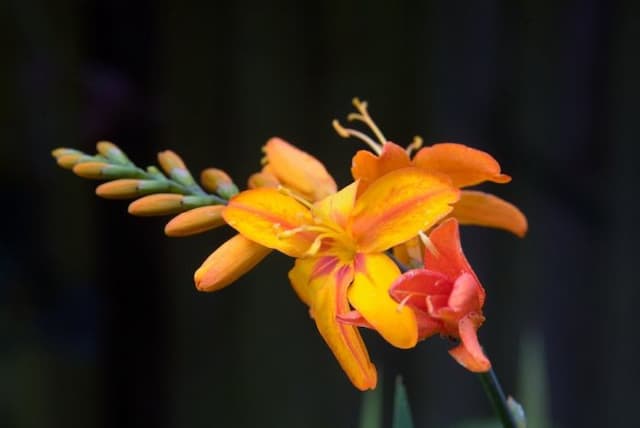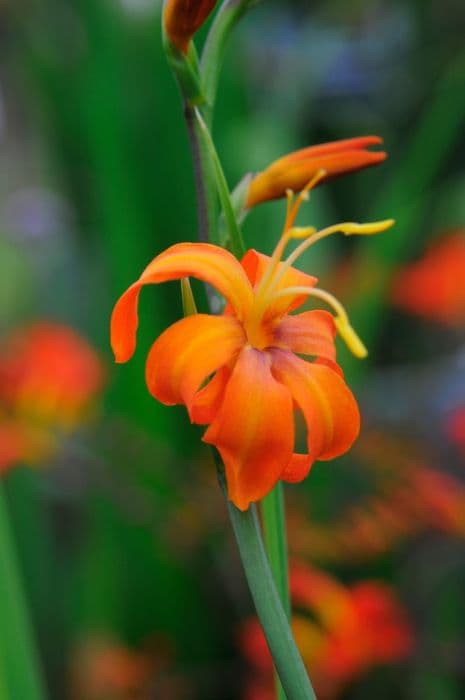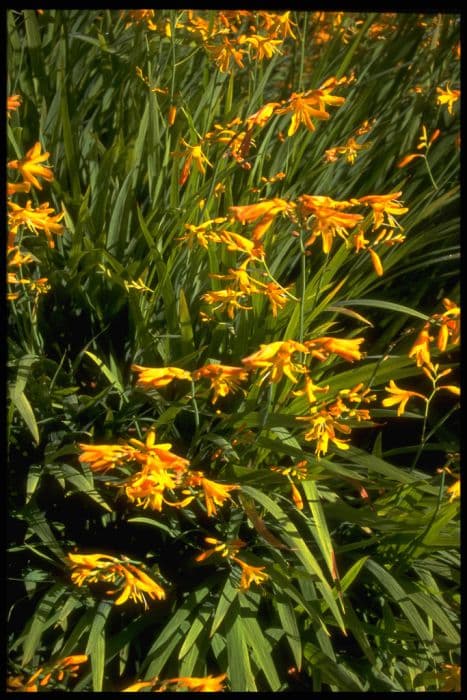Iris Iris 'No Name' (CH)

ABOUT
The Iris 'No Name' (CH) is an ornamental flower known for its unique and striking appearance. This plant produces beautiful blooms characteristic of irises, with each flower exhibiting three upright petals, often referred to as standards, and three hanging petals, known as falls. The petals may present a variety of colors, ranging from deep purples and blues to lighter shades such as yellows, whites, and even multicolored patterns with intricate veining and speckles. The flowers are situated atop long, slender stalks that emerge from a base of sword-shaped, green foliage. These leaves are generally stiff and upright, providing an attractive backdrop for the showy flowers. The striking contrast between the elegant blossoms and the verdant leaves creates an eye-catching display in any garden. The overall shape of the plant is typically clumping, with multiple stems rising directly from the rhizomes – the underground stems that spread horizontally beneath the soil surface. As a perennial, the Iris 'No Name' (CH) will re-emerge year after year, often with increasing vigor as the clump expands, resulting in a more impressive floral show with each passing season. While the Iris 'No Name' (CH) contributes height and texture to the beds and borders in which it is planted, its precise dimensions in terms of feet, inches, or any other units of measurement are not notable for the purposes of this description. The focus is solely on its aesthetic qualities, which are profoundly influenced by the form, color, and arrangement of its blooms and foliage.
About this plant
 Names
NamesFamily
Iridaceae
Synonyms
Iris 'No Name', Beardless Iris, Rhizomatous Iris
Common names
Iris 'No Name' (CH).
 Toxicity
ToxicityTo humans
The common name for Iris 'No Name' (CH) is Iris. Irises are known to contain irritants, mainly the rhizomes (bulb-like structures), which can cause symptoms if ingested. The parts of an Iris can cause severe digestive upset, evidenced by symptoms such as nausea, vomiting, abdominal pain, and diarrhea. Additionally, handling the plant may cause skin irritation due to the presence of certain compounds. It is advisable to avoid ingesting any part of the plant to prevent these adverse effects.
To pets
The common name for Iris 'No Name' (CH) is Iris. Irises are toxic to pets, including both cats and dogs. If a pet ingests parts of an Iris, especially the rhizomes, they may exhibit signs of poisoning, such as drooling, vomiting, diarrhea, and abdominal pain. In severe cases, ingestion can lead to lethargy and an increased heart rate. Owners should prevent pets from chewing on any part of the plant and should seek immediate veterinary care if ingestion is suspected.
 Characteristics
CharacteristicsLife cycle
Perennials
Foliage type
Deciduous
Color of leaves
Green
Flower color
Varies
Height
2-3 feet (0.6-0.9 meters)
Spread
1-2 feet (0.3-0.6 meters)
Plant type
Bulb
Hardiness zones
3-9
Native area
Temperate Northern Hemisphere
Benefits
 General Benefits
General Benefits- Ornamental Beauty: Irises add striking colors and unique flower shapes to gardens, making them a beautiful ornamental choice.
- Diversity in Landscaping: Their various sizes allow for usage in border plantings, rock gardens, and pond edges.
- Low Maintenance: Once established, irises generally require minimal care, making them a convenient option for gardeners with limited time.
- Drought Tolerance: Many iris varieties are drought-tolerant, suitable for xeriscaping or regions with low water availability.
- Pest Resistance: Irises are relatively resistant to deer and other pests, reducing the need for chemical repellents.
- Long Bloom Period: With proper care and selection, irises can provide a long season of blooms from late spring to early summer.
- Easy Propagation: Irises can be easily propagated by dividing rhizomes, allowing gardeners to expand their collection or share with others.
- Seasonal Interest: The foliage of irises adds texture and color to gardens even when the plants are not in bloom.
 Medical Properties
Medical PropertiesThis plant is not used for medical purposes.
 Air-purifying Qualities
Air-purifying QualitiesThis plant is not specifically known for air purifying qualities.
 Other Uses
Other Uses- Iris fibres can be used in paper-making for artistic papers, offering a distinct texture and aesthetic appeal from the inclusion of the plant's fibers.
- The blooms of the iris can be used as a natural dye, imparting colors ranging from yellows to purples depending on the species and treatment of the flowers.
- Gardeners can propagate irises to use as a natural way to reduce soil erosion, thanks to their extensive root systems that hold soil in place.
- Iris rhizomes are sometimes used in the art of perfumery, especially the Orris root, which after a long drying process, can add a violet-like scent to perfumes.
- Pressed iris flowers can be incorporated into crafts, such as in bookmarks, greeting cards, or framed art, where their beauty is preserved in a new form.
- The iris's distinctive shape and colors make it a frequent subject for photographers and painters, who utilize them in their work to capture the striking appearance of the flowers.
- Dried iris petals can also be used in potpourri mixes to add color and a gentle fragrance to a room or drawer.
- The substantial leaves of certain iris species can be used in weaving or basket-making, providing a unique material that is both durable and visually appealing.
- Culinary use of some nontoxic iris petals includes garnishing and decorating dishes, especially desserts, to add a flourish of color and a light floral taste.
- Iris plants are often used as a way to introduce children to the natural world, where planting and caring for the flowers can serve as an educational tool in schools or at home.
Interesting Facts
 Feng Shui
Feng ShuiThe Iris is not used in Feng Shui practice.
 Zodiac Sign Compitability
Zodiac Sign CompitabilityThe Iris is not used in astrology practice.
 Plant Symbolism
Plant Symbolism- Hope: The iris often signifies hope and cherished friendship. Its blooming represents faith in a brighter tomorrow.
- Wisdom: In some cultures, the iris is symbolic of wisdom and valued knowledge.
- Royalty: With its regal stance and luxurious petals, the iris is frequently associated with royalty and noble bearings.
- Valor: The flower is also a symbol of valor and bravery, reflective of its sword-shaped leaves.
- Purity: Particularly in its lighter shades, the iris conveys purity and innocence.
- Messages: The iris can represent communication and the sending of messages, possibly derived from its association with the Greek goddess Iris who was a messenger.
- Spiritual Insight: Purple irises in particular are tied to spiritual awareness and enlightenment.
 Water
WaterBearded Irises require moderate watering, and it's crucial to not overwater to prevent root rot. Water the Iris 'No Name' deeply when the top inch of soil feels dry to the touch, which may be approximately once a week during active growth in spring and summer. In the absence of rainfall, provide about a gallon of water per plant, spread out to moisten the soil to a depth of approximately 8 inches. During the dormant season in fall and winter, reduce watering to only when necessary to keep the soil from completely drying out. Always allow the soil to dry out slightly between watering sessions.
 Light
LightBearded Irises flourish in full sunlight. They prefer a spot that receives at least six to eight hours of direct sunlight daily. If you plant Iris 'No Name' in an area with too much shade, it may result in fewer blooms. Choose a location in your garden that is not overshadowed by taller plants or trees to ensure your Irises receive adequate light for healthy growth and maximum flowering potential.
 Temperature
TemperatureBearded Irises are hardy and can tolerate a range of temperatures, but they thrive best when the temperature is between 55°F and 75°F. They can generally withstand winter cold down to about -20°F and summer highs up to 90°F or more. It’s important to prevent the rhizomes from freezing, so in colder climates, a layer of mulch can help over winter.
 Pruning
PruningPruning, or more accurately, deadheading Bearded Irises, encourages further blooming and helps prevent disease. As individual flowers fade, cut the flower stalks down to the base of the plant to keep the Irises looking tidy. After the blooming season, remove any brown or damaged leaves. In late summer or early fall, cut back foliage to a height of about 6 inches to prepare the plant for winter and to prevent wind damage.
 Cleaning
CleaningAs needed
 Soil
SoilBearded Iris prefer well-draining soil with a pH between 6.0 to 7.0. An ideal soil mix for Irises would include loam, compost, and coarse sand to ensure proper drainage and aeration. It's important to avoid heavy clay or overly water-retentive mixes that can lead to root rot.
 Repotting
RepottingBearded Irises typically do not require frequent repotting; they should be divided and replanted every 3 to 5 years. This helps to avoid overcrowding and rejuvenates the plant for better blooms.
 Humidity & Misting
Humidity & MistingBearded Irises thrive in average garden humidity levels. They are quite adaptable and do not require high humidity environments to grow well. Consistently high humidity might increase the risk of fungal diseases.
 Suitable locations
Suitable locationsIndoor
Place in a sunny spot, minimize watering, ensure good air flow.
Outdoor
Full sun, well-draining soil, space rhizomes apart.
Hardiness zone
3-9 USDA
 Life cycle
Life cycleIris 'No Name' (presumably a cultivar of garden iris), like most irises, begins its life when seeds are sown in the soil and germinate, although cultivation is more commonly done via rhizome division. The first stage is the emergence of seedlings or new growth from divided rhizomes, where roots establish themselves in the soil and foliage begins to develop. As the plant matures, it forms a sturdy stem and long, sword-like leaves, preparing for the flowering stage. Flowering typically occurs in late spring to early summer, revealing the iris's distinctive and ornamental blooms which can vary in color depending on the cultivar. After pollination, if it occurs, the flowers will wilt and seed pods may develop; these dry out and eventually release the seeds, thus continuing the cycle. Finally, as a perennial, the iris will enter a period of dormancy in the late fall or winter, with the rhizome surviving underground until the cycle restarts with new growth in the spring.
 Propogation
PropogationPropogation time
Spring-Early Summer
Propogation: The most popular method of propagating Iris 'No Name', commonly known as bearded iris, is through rhizome division. This is best done in late summer after the iris has bloomed and enters a period of dormancy. To propagate, first carefully dig up the clump of iris, trying not to damage the rhizomes. Brush off the dirt and inspect the rhizomes for signs of disease or pests, discarding any that appear unhealthy. Identify sections of rhizome that have at least one fan of leaves and a firm, healthy appearance. Using a sharp knife, cut apart these sections, ensuring each piece has one or more growth points or "eyes". Allow the cuts to dry for a few hours to form a callous, which helps prevent rotting. Finally, replant the divisions about 12 to 24 inches apart (30 to 60 centimeters) and one inch deep (2.5 centimeters) into well-drained soil, with the leaves facing the sun. Water the newly planted rhizomes well to establish them.
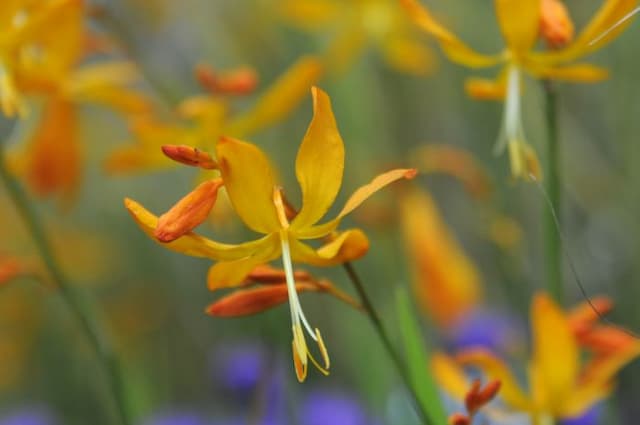
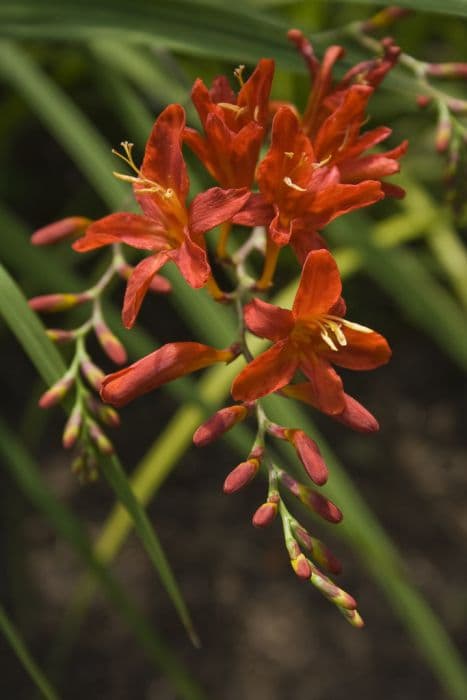
![Montbretia [Bright Eyes]](/_next/image?url=https%3A%2F%2Fplants-admin.emdemapps.com%2Fimages%2Fplants%2F%2Fimages%2F604b5f4a483b6.png&w=640&q=75)
